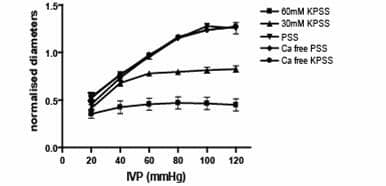Myogenic reactivity is an important regulatory mechanism for maintaining arterial diameter in the face of changing physical stresses. Although well-studied in many vascular beds, surprisingly little is known as to the nature of myogenicity in arteries serving the uterus, which is particularly important given the substantial haemodynamic changes occurring in this organ during pregnancy. Therefore, the aim of this study was to investigate myogenic responsiveness of pressurised uterine arteries, isolated from rats, to changes in intravascular pressure (IVP). Virgin adult Sprague Dawley rats (150-250g) were humanely killed by stunning and cervical dislocation. Third order uterine arteries were dissected and mounted on an arteriograph and pressurised to 60mmHg. Arteries were superfused at 37°C with physiological salt solution (PSS), gassed with 95% air/5% CO2 and left for 90 minutes to determine the extent of myogenic tone development. The subsequent influence of step-wise (5 min) IVP changes (20-120mmHg) in 20mmHg increments was investigated in arteries with and without pre-constriction to KPSS (30mM or 60mM) or AVP at a concentration determined to produce 50% of maximal constriction to AVP. Endothelium integrity was tested by addition of 10µM Carbachol. Experiments were repeated in calcium-free PSS or KPSS. Mean arterial lumen diameters (at 60mmHg) were 152.4± 4.74µm and 156.4 ± 4.45µm (mean ± SEM) in calcium-containing and calcium-free PSS respectively. Development of myogenic tone was not observed. 60mM KPSS produced a sustained narrowing of arteries (diameter change 76.4 ± 8.5µm, n=5), whilst 30mM KPSS produced a constriction approximately half of this (diameter change 28.4 ± 5.9µm, n=5). The constriction produced by AVP (0.08-0.55 µM) was similar to that produced by 30mM KPSS (35.6 ± 4.8µm, n=8). In calcium-free PSS and KPSS increases in IVP produced sequential increases in diameter of all arteries. The responses of arteries in calcium-containing PSS (minus constrictor) were similar. However, arteries pre-constricted with KPSS (30 or 60mM) or AVP exhibited active regulation in response to increases in IVP such that stable diameters were maintained (over 40-120mmHg) (See figure). These results indicate that isolated uterine arteries from the non-pregnant rat, when held at an in vitro pressure of 60mmHg, do not develop spontaneous myogenic tone. Nonetheless, under the influence of pre-constrictory stimuli of varying magnitude, such vessels do exhibit prominent myogenic responsiveness to IVP changes. These observations have important implications for understanding local autoregulation in the uterine circulation. Supported by the BHF.
University of Edinburgh (2007) Proc Physiol Soc 6, C2
Research Symposium: Myogenic regulation to intravascular pressure changes of uterine arteries isolated from non-pregnant rats
S. Withers1, M. J. Taggart1, P. Baker2, C. Austin1
1. Cardiovascular and endocrine sciences, University of Manchester, Manchester, United Kingdom. 2. Maternal and Fetal Health Research Centre, The University of Manchester, St Mary's Hospital, Manchester, United Kingdom.
View other abstracts by:
The response of isolated pressurised arteries from non-pregnant rats to changes in IVP.
Where applicable, experiments conform with Society ethical requirements.

